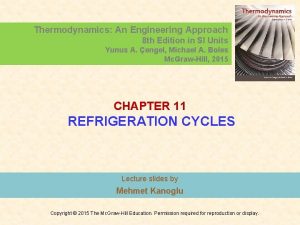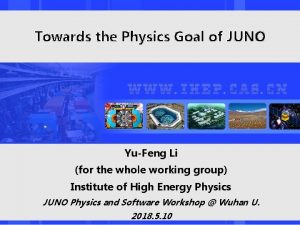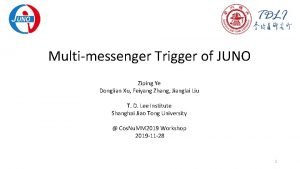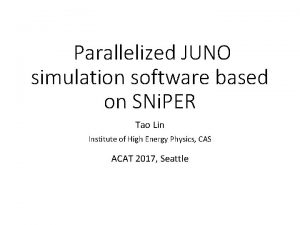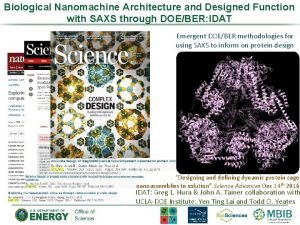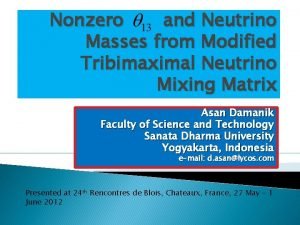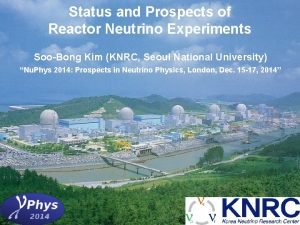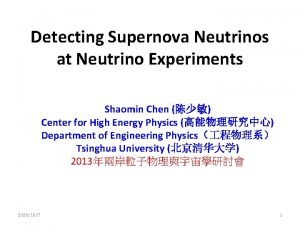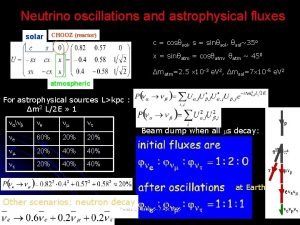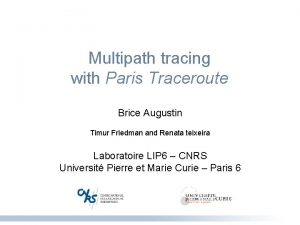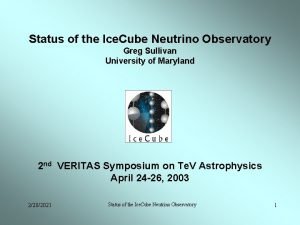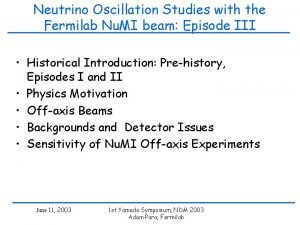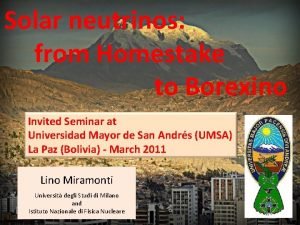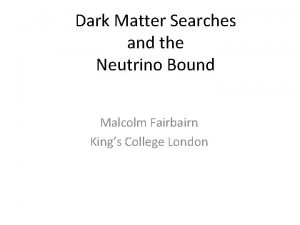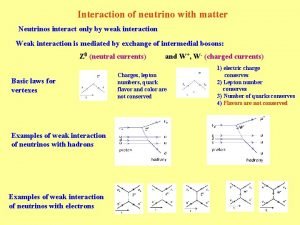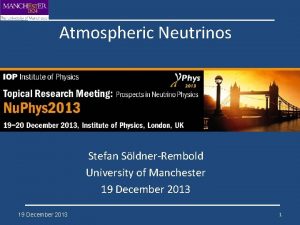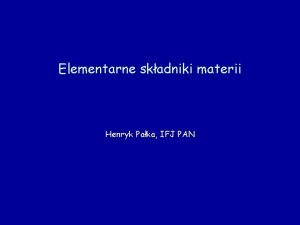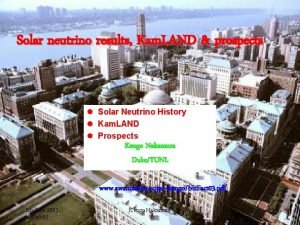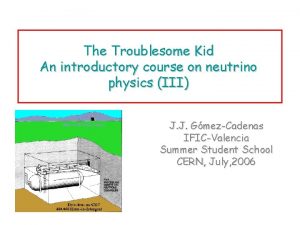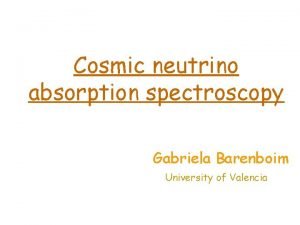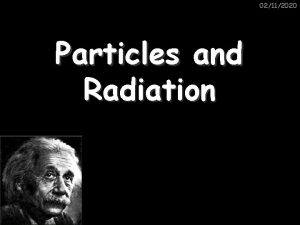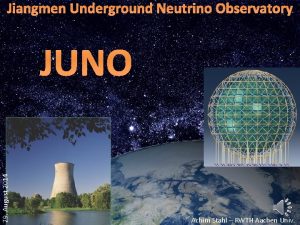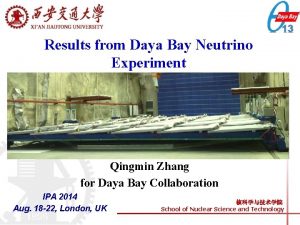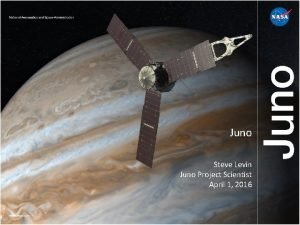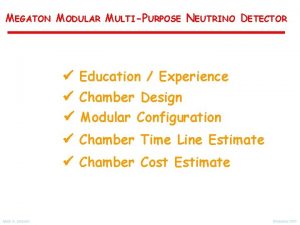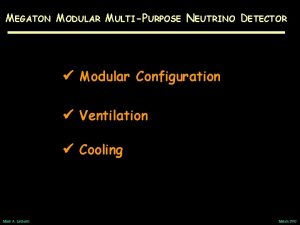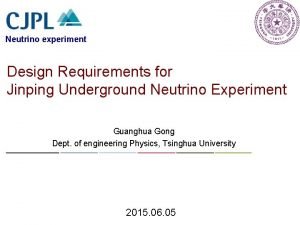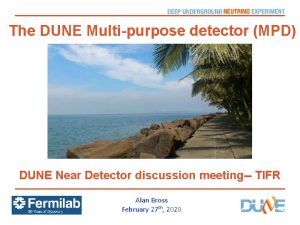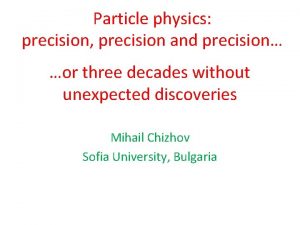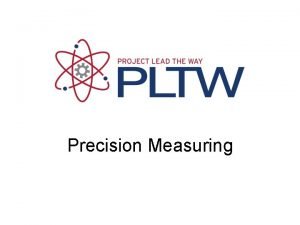JUNO A Multipurpose Underground Precision Neutrino Detector Qingmin



































- Slides: 35

JUNO: A Multipurpose Underground Precision Neutrino Detector Qingmin Zhang (On behalf of JUNO Collaboration) School of Nuclear Science and Technology Xi’an Jiaotong University Jul. 5 th, 2018 Institute of Nuclear Technology 核科学与技术学院 School of Nuclear Science and Technology

Outline 1. 2. 3. 4. 5. Page 2/17 JUNO Introduction JUNO Detector R&D JUNO Physics Goals and Potentials Milestones & Schedule Summary School of Nuclear Science and Technology

1. JUNO Introduction Page 3/17 The Jiangmen Underground Neutrino Observatory (JUNO) is designed to primarily determine the neutrino Mass Hierarchy by detecting reactor anti neutrinos via inversed beta decay. Ø Non-zero and large θ 13 discovery opens a door to neutrino Mass Hierarchy. Ø JUNO was proposed in 2008, approved in 2013 PRL 108, 171803 (2012) School of Nuclear Science and Technology

JUNO Location Page 4/17 NPP Daya Bay Huizhou Lufeng Yangjiang Taishan Status Operational Planned Under construction 17. 4 GW 18. 4 GW Power 17. 4 GW by 2020: 26. 6 GW Overburden ~ 700 m Previous site candidate Guang Zhou Kaiping, Jiangmen city, Guangdong Province 2. 5 h drive Shen Zhu Hai 53 km Huizhou NPP Lufeng NPP Daya Bay NPP Hong Kong Macau 53 km Yangjiang NPP Taishan NPP • 4 School of Nuclear Science and Technology

JUNO Collaboration The JUNO Collaboration Armenia. Yerevan Physics Institute Belgium. Université libre de Bruxelles Brazil PUC Rio de Janeiro Brazil UE Londrina Chile PCUC Chile UTFSM Valparaiso BISEE Beijing Normal U. CAGS Chong. Qing University China CIAE DGUT ECUST Guangxi U. Harbin Institute of Technology IHEP IMP-CAS Jilin U. Jinan U. Nanjing U. Nankai U. NUDT NCEPU Pekin U. Shandong U. Shanghai JT U. SYSU Tsinghua U. UCAS USTC U. of South China Wu Yi U. Wuhan U. Xi'an JT U. Xiamen University Collaboration established in July 2014 Now: 72 institutions, 593 collaborators Page 5/17 Zhengzhou U. Taiwan National Chiao-Tung U. Taiwan National Taiwan U. Taiwan National United U. Czech R. Charles U. Prague Finland U. Jyväskylä France APC Paris France CENBG Bordeaux France CPPM Marseille France IPHC Strasbourg France Subatech Nantes Germany ZEA FZ Julich Germany RWTH Aachen U. Germany TUM Germany U. Hamburg Germany IKP-2 FZ Jülich Germany U. Mainz Germany U. Tuebingen Italy INFN Catania Italy INFN di Frascati Italy INFN-Ferrara Italy INFN-Milano Bicocca Italy INFN-Padova Italy INFN-Perugia Italy INFN-Roma 3 Latvia IECS Riga Pakistan PINSTECH Islamabad Russia INR Moscow Russia JINR Russia MSU Slovakia U. Bratislava FMPICU Thailand NARIT Thailand PPRLCU Bangkok Thailand SUT USA UMD 1 USA UMD 2 School of Nuclear Science and Technology

2. JUNO Detector R&D Page 6/17 p Veto Detector ü Water Cherenkov detector: track muons and shield ambient radioactivity ü Top Trackers: independent muon tracking Energy resolution: ~ 3%/√E p Central Detector ü ~20 kt @ Φ 35. 4 m (Largest LS detector) filled with LS. ü Equipped with ~18 k high QE 20” PMTs ü 25 k 3” PMTs for better timing and higher saturation energy Energy Non-linearity : < 1% Overburden of~700 m rock for cosmic ray shielding p Calibration system ü Multiple sources: e+, γ, n ü Full volume positioning School of Nuclear Science and Technology

2. 1 Liquid Scintillator Page 7/17 p Requirements for LS: ü High light-yield: 104 photons/Me. V ü High transparency: Attenuation Length: >20 m@430 nm ü Low background: 238 U <10 15 g/g, 232 Th<10 15 g/g, 40 K<10 17 g/g p LS Recipe ü ü based on Daya bay Solvent: Linear Alkyl Benzene 2. 5 g/L PPO 1 4 mg/L bis MSB p Purification pilot plant ü Under operation at Daya Bay ü Distillation, Al 2 O 3 column purification, water extraction and gas stripping ü > 23 m A. L. after filling (w/o bis-MSB) 2. 5 g/L PPO 1 -3 mg/L bis-MSB School of Nuclear Science and Technology

2. 2 PMTs Page 8/23 p 20” PMTs with High QE ü 15 k NNVT MCP PMT: newly developed by North Night Vision Technology (NNVT), latest 300 PMTs’ Detection efficiency is > 30% Characteristics ü 5 k Hamamatsu R 12860 Detection Eff. (QE×CE*area) (%) P/V of SPE TTS on the top point (ns) Rise time/Fall time(ns) Anode Dark count(Hz) After Pulse (%) Glass Radioactivity (ppb) MCP PMT R 12860 27%, >24% 3. 5, >2. 8 ~12, <15 R~5; F~12 20 k, <30 k 1, <2 238 U: 50 232 Th: 50 40 K: 20 3, >2. 5 2. 7, <3. 5 R~5, <7; F~9, <12 10 k, <50 k 10, <15 238 U: 400 232 Th: 400 40 K: 40 Protection cover is designed to prevent chain implosion reaction School of Nuclear Science and Technology

2. 3 Veto system Page 9/17 u Cosmogenic isotopes reduction (9 Li/8 He) → precise muon track u Fast neutrons background rejection → shielding and tagging u Radioactivity from rock → passive shielding by water Water Cherenkov detector p 20 -30 kton ultrapure water is supplied and maintained by circulation system(<0. 2 Bq/m 3) p ~2400 20’’ PMTs p Detection efficiency >95% Top Tracker p Reuse plastic scintillator from OPERA p 3 layers to cover 1/2 on top. p Each module are readout at both ends by multi anode photomultipliers. School of Nuclear Science and Technology

2. 4 Calibration System Automatic Calibration Unit (ACU) Guide Tube Calibration System(GTCS) Page 10/17 Cable Loop System (CLS) Remotely Operated under liquid scintillator Vehicles (ROV) p Complementary for covering entire energy range of reactor neutrinos and full volume position coverage inside JUNO central detector School of Nuclear Science and Technology

3. JUNO Physics Goals and Potentials Page 11/17 Target Mass Photoelectron Yield (PE/Me. V) Photocathode Coverage Daya Bay BOREXINO Kam. LAND ~20 t ~300 t ~1 kt ~160 ~500 ~250 JUNO ~20 kt ~1200 ~12% ~34% ~78% Energy Resolution ~7. 5%/√E ~6%/√E <3%/√E Energy Non linearity ~1. 5% ~1% ~2% <1% Due to its large scale and best performance, JUNO will be an exceptional detector and it has rich physics potentials. School of Nuclear Science and Technology

3. 1 Mass Hierarchy Page 12/23 p Oscillation probability is independent of CP phase and θ 23 (Reactor neutrinos) n The big suppression is the “solar” oscillation ( Δ m 212 , sin 2θ 12 ) n “Large” value of θ 13 is crucial School of Nuclear Science and Technology

Page 13/17 p Sensitivity with 100 k events (~6 yrs) n No pre condition of Δm 232 n Only depends on shape but not absolute peak position ü No constraint: ü With 1% constraint: School of Nuclear Science and Technology

3. 2 Measurement of Oscillation Parameters Page 14/17 Due to good energy resolution and proper baseline, JUNO can help to: Ø Improve precisions of three parameters (Δm 221, Δm 2 ee and sin 2θ 12 ) to sub percent level, several times improvement compared with current precision. Ø Probe the unitarity of UPMNS to ~1% level School of Nuclear Science and Technology

3. 3 Neutrino Astrophysics and Others Page 15/17 p Neutrinos from the Earth escape freely and bring the information about U, Th and K abundances and their distributions p Due to its largest LS size, the expected geo neutrino rate in JUNO is ~1. 1/day. p Within the 1 st year, JUNO will record more geo neutrino events than all other detectors Øwill have accumulated until then. JUNO will be the most precise experiment for geo-neutrino study. In the meanwhile, JUNO is also attractive for other neutrino astrophysics, such as supernova neutrinos, diffuse supernova neutrinos, solar neutrinos and atmospheric neutrinos. Beside these, additional physics is also rich in JUNO ØSterile neutrinos ØDark matter searches Ø Proton decay Ø Other exotic searches School of Nuclear Science and Technology

4. Milestones & Schedule Page 16/17 2021: 2019 2020: 2017: 2016: 2015: 2014: l PMT production line setup l CD parts R&D l Start PMT testing l TT arrived l Detector ready for Data taking! l Electronics production 2018: starts l Civil work and l PMT potting lab preparation l starts Delivery Completed of surface l Detector buildings constructing l Start production of acrylic sphere l Start PMT production l Start CD parts production l International collaboration established l Start civil construction School of Nuclear Science and Technology

5. Summary Page 17/23 p JUNO is a multipurpose underground precision neutrino detector, which is a very active R&D program and will achieve design goals. p JUNO will measure Mass hierarchy (3 ‐ 4 σ in 2027) and 3 oscillation parameters to <1% level, with other rich physics potentials, such as supernova, geo neutrino, solar neutrino, sterile neutrino. p JUNO detector R&D and fabrication are progressing smoothly, aiming at data taking in 2021. Thanks for your attention! School of Nuclear Science and Technology

Backup Slides School of Nuclear Science and Technology

JUNO Requirements Page 19 p Reactor baseline variation: < 0. 5 km ü JUNO site meets this requirement p Energy resolution: ~ 3%/√E • The crucial parameter p Energy Non linearity : < 1% ü Large non linearity could lead to wrong answer p Statistics: 100 k events in 6 yrs ü 26. 6 35. 7 GW reactor power ü 20 kton detector (→ ~60 evts/day) p Background minimization ü Deep underground ü Precision muon tracking to maximize exposure ü Minimization of Material Radioactivity School of Nuclear Science and Technology

Comparisons Page 20 JUNO will be an exceptional detector Target Mass Photoelectron Yield (PE/Me. V) Photocathode Coverage Daya Bay BOREXINO Kam. LAND ~20 t ~300 t ~1 kt ~160 ~500 ~250 JUNO ~20 kt ~1200 ~12% ~34% ~78% Energy Resolution ~7. 5%/√E ~6%/√E <3%/√E Energy Non linearity ~1. 5% ~1% ~2% <1% School of Nuclear Science and Technology

JUNO Physics Goals and Potentials Supernova 5 -7 k in 10 s for 10 kpc Solar (10 s-1000 s)/day 36 GW, 53 km reactor , 60/day Bkg: 3. 8/day Atmospheric several/day Page 21 JUNO has rich physics possibilities 700 m Cosmic muons ~ 250 k/day 20 k ton LS 0. 003 Hz/m 2 215 Ge. V 10% multiple-muon Geo-neutrinos 1. 1/day School of Nuclear Science and Technology

Supernova Neutrinos Page 22 Ø SN detection is an ideal probe for astrophysics and particle physics. Ø Largest LS detector of new generation high statistics, good en resolution and flavor information. • Three Phases of Neutrino Emission 1. Infall (Bounce and Shock Propagation, few tens of ms after bounce) 2. Accretion (Shock Stagnation, few tens to few hundreds of ms) 3. Neutron star cooling (lasts until 10– 20 s) l Advantage: Global l analysis of all channels l l Real time meas. of three phase ν signals Distinguish between different ν flavors Reconstruct ν energies and luminosities Almost background free due to time info School of Nuclear Science and Technology

Diffused SN Background Page 23 p About 10 core collapses/sec in the visible universe Emitted �� energy density is ~extra galactic background light and ~10% of CMB density p Confirm star formation rate p Pushing frontiers of neutrino astronomy to cosmic distances JUNO Advantages: Ø Excellent intrinsic capabilities of LS detectors for antineutrino tagging Ø Excellent Background Rejection 90% CL exclusion curves (the upper right regions) if no detection for 10 yrs Observation window: 11 Me. V < Eν< 30 Me. V PSD techniques for NC atmospheric ν (critical) Fast neutrons: r < 16. 8 m (equiv. 17 kt mass) p A positive signal @ 3σ level is conceivable for a 10 year measurement p A non detection would strongly improve current limits and exclude a significant range of DSNB parameter space. School of Nuclear Science and Technology

Solar neutrinos Page 24 JUNO advantages for solar ν detection ü large mass and lower E threshold 7 Be and low tail of 8 B ü Expected σ(E) ≈ 3%/√E can discriminate p p from 14 C Main challenges n Radio puritysimilar to previous LS experiments n Cosmogenic background, e. g. long lived 11 C under 8 B The expected singles spectra at JUNO with the “baseline” radiopurity requirements (Assumed radio purity gives S: B≈1: 3) School of Nuclear Science and Technology

Geo neutrinos Page 25 • Anti neutrinos from the Earth escape freely from the earth interior and bring the information about the U, Th and K abundances and their distributions inside the planet to earth surface • Because of largest size of its LS detector, within the first year of running JUNO will record more geo neutrino events than all other detectors will have accumulated until then. p ~1. 1/day @JUNO after IBD Selection p The expected geo neutrino signal at JUNO as a function of radiogenic heat due to U and Th in the Earth, H(U+Th). School of Nuclear Science and Technology

light sterile neutrino searches Page 26 • Sterile neutrinos at the e. V or sub e. V scale are well motivated by the short baseline neutrino oscillation anomalies. • Without an additional near detector, reactor antineutrino oscillations cannot search for e. V scale sterile neutrinos. However, the diameter of the JUNO central detector (~35 m) enables source based method because of both purity of their source and the possibility to probe the baseline dependence Radioactive Source Selection Requirement ü A pair parent and daughter nucleus: • Parent nucleus: Low-Q , Long life: Easy to transport and storage • Daughter nucleus: High Q, Short life: produce antineutrinos with energy above 1. 8 Me. V (IBD threshold) ü Spent fuel of reactors is preferred because it’s easy to and cheap to obtain. 144 Ce-144 Pr is favorable Simple Spentfuel Model & Shape-only Analysis School of Nuclear Science and Technology

Atmospheric neutrinos Page 27 n Our focus on JUNO atmospheric neutrinos is to make a complementary mass hierarchy measurement. n For the upward atmospheric neutrinos, the oscillation probabilities P(νμ → νμ) and P(νe → νμ) in the NH and IH cases have obvious differences due to the MSW resonance effect. Here we only consider νμ and νμ charged current (CC) events. μ± tracks are required to have a length Lμ > 5 m p JUNO’s MH sensitivity can reach 0. 9 σ for a 200 kton years exposure and sin 2 θ 23 = 0. 5, which is complementary to the JUNO reactor neutrino results. School of Nuclear Science and Technology

Indirect Detection of Dark Matter Page 28 p. Dark matter (DM) can be trapped in the Galactic halo, the Sun or the Earth p. Annihilation or decays of trapped DM particles �� can be detected indirectly by looking for their neutrino signature direction information needed (muon neutrino events preferred) p. Expected neutrino fluxes resulting from DM annihilation or decays can be established based on different models To estimate JUNO sensitivity, we focus on ü muon type events above 1 Ge. V coming from a 30 degree solid angle range surrounding the direction of the Sun, ü χχ→ τ + τ and χχ → νν are considered as a bench mark; ü Assuming Bχ τ ν = 1 School of Nuclear Science and Technology

Opportunity in Proton Decay Page 29 • The prompt signal K+ overlaps with its decay to muon signal → one prompt signal → two pulse events • Main background comes from one pulse atmospheric neutrino interactions • Pulse shape discrimination of the combined prompt signal is the key to distinguish the signal from atmospheric neutrino background • Time span between 15% and 85% of the maximum pulse height greater than 7 ns can retain 65% signal while rejecting almost all muon neutrino backgrounds Note: In comparison, Super K’s sensitivity is projected to the year of 2028. School of Nuclear Science and Technology

JUNO Detectors Blue: Veto Calibration LS/Water Filling room Top Tracker Earth Magnetic Field shielding coils Central detector Steel Structure + Acrylic sphere + 20 kt Liquid Scin Yellow: CD Pool’s height 44 m Water depth 43. 5 m Acrylic sphere: ID 35. 4 m Stainless steel latticed shell: ID 40. 1 m ~18000 20” PMT+ ~25000 3’’ PMT Water Cherenkov ~2400 20’’ PMT Water pool diameter: 43. 5 m School of Nuclear Science and Technology

3” PMTs Page 31 p 25, 000 3” PMTs contracted with HZC: an vital “aider” to 20’’ PMTs Small size no saturation and better linearity in JUNO situation Mixture of 20’’ and 3’’ Can serve as a standalone calorimeter PMTs p 4000 produced, 3000 tested at HZC 200 boxes × 128 PMTs JUNO custom design: XP 72 B 22 ü QE 24% , P/V 3. 0 ü SPE resolution 30% ü TTS 2 -5 ns Prototype already built School of Nuclear Science and Technology

Water Cherenkov detector p 20 -30 kton ultrapure water is supplied and maintained by circulation system(<0. 2 Bq/m 3) p ~2. 4 k 20’’ PMTs p Detection efficiency >95% ü Fast neutron background ~0. 1/day ü Water buffer is 3. 2 m from rock to central detector ü Radioactive background from rock is 7. 4 Hz @3. 2 m water buffer Page 32 Lining High Density Polyethylene Welding School of Nuclear Science and Technology

Top Tracker Page 33 p. Complementary p. Reuse Target Tracker of OPERA experiment (plastic scintillator ) p. Arranged in 3 horizontal layers spaced by 1 m to cover half of the top area. p. All the 64 WLS fibers of one module are read at both ends by two 64 channels multi anode photomultipliers (Ma. PMT). Select “gold” muons for radioactive events reduction • Ensure good muon tracking • Perform a precise muon tracking and provide valuable information for cosmic muon-induced 9 Li/8 He study. School of Nuclear Science and Technology

Calibration System Page 34 u Radioactive sources γ: 40 K, 54 Mn, 60 Co, 137 Cs e+: 22 Na, 68 Ge n: 241 Am-Be, 241 Am- 13 C or 241 Pu- 13 C, 252 Cf u Position Control 1 D: Automatic Calibration Unit (ACU) for central axis scan 2 D: Cable Loop System (CLS) for one vertical plane scan + Guide Tube Calibration System(GTCS) for CD outer surface 3 D: Remotely Operated under liquid scintillator Vehicles (ROV) for whole CD scan School of Nuclear Science and Technology

Page 35 p These 4 calibration systems are complimentary for covering entire energy range of reactor neutrinos and achieving full volume position coverage inside JUNO central detector. System Position Control Source change Others ACU Manual Automatic GTCS Spool drive (steel wire coated with Teflon Φ 1. 0) +Tension Control ROV Remotely Operated Vehicle Manual CLS All critical, have to be combined Manual Insurance School of Nuclear Science and Technology
 Bcd gösterimi
Bcd gösterimi Non precision tools
Non precision tools Semi-precision attachment
Semi-precision attachment Refrigeration cycle thermodynamics
Refrigeration cycle thermodynamics Introduction of mudaliar commission
Introduction of mudaliar commission Multipurpose refrigeration systems with a single compressor
Multipurpose refrigeration systems with a single compressor Hera campana
Hera campana Whos roman name is diana
Whos roman name is diana Juno docdb
Juno docdb Juno
Juno Juno
Juno What are the juno awards named after
What are the juno awards named after Son of juno
Son of juno Why does juno hate aeneas
Why does juno hate aeneas Juno roman goddess
Juno roman goddess Juno genre
Juno genre Juno izumo
Juno izumo Dionysus roman name and symbol
Dionysus roman name and symbol Neutrino
Neutrino Neutrino
Neutrino Neutrino
Neutrino Neutrino beteckning
Neutrino beteckning Neutrino
Neutrino Neutrino load balancer
Neutrino load balancer Ice cube para status
Ice cube para status Neutrino
Neutrino Solar neutrino
Solar neutrino Neutrino
Neutrino Leptons
Leptons Neutrino interaction with matter
Neutrino interaction with matter Neutrino
Neutrino Lekka cząstka elementarna mion elektron lub neutrino
Lekka cząstka elementarna mion elektron lub neutrino Solar neutrino
Solar neutrino Neutrino
Neutrino Neutrino density
Neutrino density Neutrino lepton number
Neutrino lepton number





